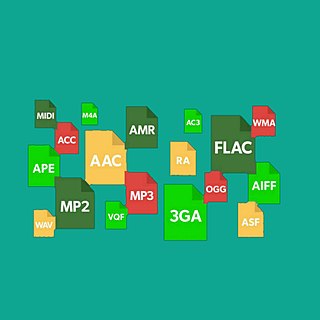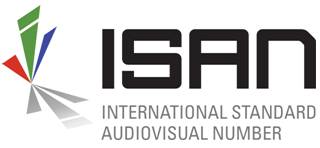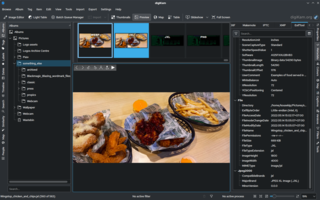
An audio file format is a file format for storing digital audio data on a computer system. The bit layout of the audio data is called the audio coding format and can be uncompressed, or compressed to reduce the file size, often using lossy compression. The data can be a raw bitstream in an audio coding format, but it is usually embedded in a container format or an audio data format with defined storage layer.

The International Standard Book Number (ISBN) is a numeric commercial book identifier that is intended to be unique. Publishers purchase or receive ISBNs from an affiliate of the International ISBN Agency.
Waveform Audio File Format is an audio file format standard for storing an audio bitstream on personal computers. The format was developed and published for the first time in 1991 by IBM and Microsoft. It is the main format used on Microsoft Windows systems for uncompressed audio. The usual bitstream encoding is the linear pulse-code modulation (LPCM) format.

The International Federation of the Phonographic Industry (IFPI) is the organisation that represents the interests of the recording industry worldwide. It is a non-profit members' organisation registered in Switzerland and founded in Italy in 1933 by Francesco Braga. It operates a secretariat based in London, with regional offices in Brussels, Hong Kong, Miami, Abu Dhabi, Singapore and Nairobi.

ISO 3166-1 alpha-2 codes are two-letter country codes defined in ISO 3166-1, part of the ISO 3166 standard published by the International Organization for Standardization (ISO), to represent countries, dependent territories, and special areas of geographical interest. They are the most widely used of the country codes published by ISO, and are used most prominently for the Internet's country code top-level domains. They are also used as country identifiers extending the postal code when appropriate within the international postal system for paper mail, and have replaced the previous one consisting one-letter codes. They were first included as part of the ISO 3166 standard in its first edition in 1974.

An International Standard Serial Number (ISSN) is an eight-digit serial number used to uniquely identify a serial publication (periodical), such as a magazine. The ISSN is especially helpful in distinguishing between serials with the same title. ISSNs are used in ordering, cataloging, interlibrary loans, and other practices in connection with serial literature.
ISO 9362 is an international standard for Business Identifier Codes (BIC), a unique identifier for business institutions, approved by the International Organization for Standardization (ISO). BIC is also known as SWIFT-BIC, SWIFT ID, or SWIFT code, after the Society for Worldwide Interbank Financial Telecommunication (SWIFT), which is designated by ISO as the BIC registration authority. BIC was defined originally as Bank Identifier Code and is most often assigned to financial organizations; when it is assigned to non-financial organization, the code may also be known as Business Entity Identifier (BEI). These codes are used when transferring money between banks, particularly for international wire transfers, and also for the exchange of other messages between banks. The codes can sometimes be found on account statements.

A digital object identifier (DOI) is a persistent identifier or handle used to uniquely identify various objects, standardized by the International Organization for Standardization (ISO). DOIs are an implementation of the Handle System; they also fit within the URI system. They are widely used to identify academic, professional, and government information, such as journal articles, research reports, data sets, and official publications.
Registration authorities (RAs) exist for many standards organizations, such as ANNA, the Object Management Group, W3C, and others. In general, registration authorities all perform a similar function, in promoting the use of a particular standard through facilitating its use. This may be by applying the standard, where appropriate, or by verifying that a particular application satisfies the standard's tenants. Maintenance agencies, in contrast, may change an element in a standard based on set rules – such as the creation or change of a currency code when a currency is created or revalued. The Object Management Group has an additional concept of certified provider, which is deemed an entity permitted to perform some functions on behalf of the registration authority, under specific processes and procedures documented within the standard for such a role.
International Standard Musical Work Code (ISWC) is a unique identifier for musical works, similar to ISBN for books. It is adopted as international standard ISO 15707. The ISO subcommittee with responsibility for the standard is TC 46/SC 9.

International Standard Audiovisual Number (ISAN) is a unique identifier for audiovisual works and related versions, similar to ISBN for books. It was developed within an ISO TC46/SC9 working group. ISAN is managed and run by ISAN-IA.
A container format or metafile is a file format that allows multiple data streams to be embedded into a single file, usually along with metadata for identifying and further detailing those streams. Notable examples of container formats include archive files and formats used for multimedia playback. Among the earliest cross-platform container formats were Distinguished Encoding Rules and the 1985 Interchange File Format.
IPI is a unique identifying number assigned by the CISAC database to each Interested Party in collective rights management. It is used worldwide by more than 120 countries and three million right holders.
The International Standard Text Code (ISTC) is a unique identifier for text-based works. The ISO standard was developed by TC 46/SC 9 and published in March 2009 as ISO 21047:2009. The authority responsible for implementing the standard was assigned to The International ISTC AgencyArchived 2014-07-15 at the Wayback Machine. That Agency ceased operations in 2017. Following a public call for a new organization to support the maintenance and registration of ISTC data in which no other organizations stepped forward, and a subsequent report produced by ISO TC 46/SC 9 on text identification, the ISTC standard was withdrawn from the ISO catalogue of standards in August 2021.

A tag editor is an app that can add, edit, or remove embedded metadata on multimedia file formats. Content creators, such as musicians, photographers, podcasters, and video producers, may need to properly label and manage their creations, adding such details as title, creator, date of creation, and copyright notice.

MPEG-4 Part 14, or MP4, is a digital multimedia container format most commonly used to store video and audio, but it can also be used to store other data such as subtitles and still images. Like most modern container formats, it allows streaming over the Internet. The only filename extension for MPEG-4 Part 14 files as defined by the specification is .mp4. MPEG-4 Part 14 is a standard specified as a part of MPEG-4.
The Global Release Identifier (GRid) is a system to identify releases of digital sound recordings for electronic distribution. It is designed to be integrated with identification systems deployed by key stakeholders from across the music industry.
The Entertainment Identifier Registry, or EIDR, is a global unique identifier system for a broad array of audiovisual objects, including motion pictures, television, and radio programs. The identification system resolves an identifier to a metadata record that is associated with top-level titles, edits, DVDs, encodings, clips, and mashups. EIDR also provides identifiers for video service providers, such as broadcast and cable networks.
The Colombian Association of Phonogram Producers was a trade group representing the recording industry in Colombia.
The International Standard Link Identifier (ISLI), is an identifier standard. ISLI is a universal identifier for links between entities in the field of information and documentation. It was developed by the International Organization for Standardization (ISO) and published on May 15, 2015. ISO/TC 46/SC 9 is responsible for the development of the ISLI standard.









